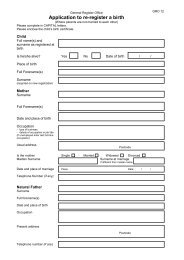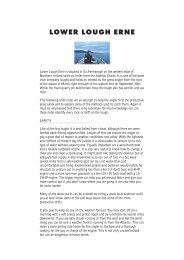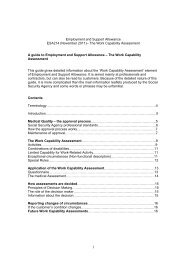an instructors guide to delivering compulsory basic training - NIDirect
an instructors guide to delivering compulsory basic training - NIDirect
an instructors guide to delivering compulsory basic training - NIDirect
You also want an ePaper? Increase the reach of your titles
YUMPU automatically turns print PDFs into web optimized ePapers that Google loves.
2. CBT Syllabus<br />
Pupils need <strong>to</strong> be made aware of the role they have in protecting the environment.<br />
Incorrectly fitted, worn or noisy exhaust systems c<strong>an</strong> lead <strong>to</strong> excessive emissions <strong>an</strong>d<br />
noise levels in excess of the legal limit.<br />
The disposal of waste materials (tyre, batteries etc) resulting from replacement parts<br />
or a ch<strong>an</strong>ge of engine or gear-box oil needs <strong>to</strong> be carried out in <strong>an</strong> environmentally<br />
friendly m<strong>an</strong>ner. All of these issues should be covered during this element of CBT.<br />
Basic skills - While your pupils are not expected <strong>to</strong> have the knowledge or practical<br />
skills of a mo<strong>to</strong>rcycle mech<strong>an</strong>ic, they will need <strong>to</strong> be able <strong>to</strong> recognise <strong>basic</strong> faults<br />
which could affect their mo<strong>to</strong>rcycle’s roadworthiness.<br />
Parking <strong>an</strong>d use of the st<strong>an</strong>ds<br />
Pupils should underst<strong>an</strong>d the import<strong>an</strong>ce of selecting a safe, legal <strong>an</strong>d convenient<br />
place when parking their mo<strong>to</strong>rcycle. You should give examples, including why they<br />
should not park at night facing the wrong direction. Discuss the risks associated with<br />
leaving a mo<strong>to</strong>rcycle in <strong>an</strong> unlit or remote area.<br />
You also need <strong>to</strong> <strong>to</strong>uch on the security aspects when parking the mo<strong>to</strong>rcycle <strong>an</strong>d<br />
leaving it unattended. The possible use of visual devices <strong>an</strong>d the benefits of <strong>an</strong>titheft<br />
devices, alarms <strong>an</strong>d/or immobilisers.<br />
Once a suitable location has been selected you need <strong>to</strong> explain <strong>an</strong>d demonstrate<br />
<strong>to</strong> your pupils the correct procedures for dismounting a mo<strong>to</strong>rcycle. This should<br />
include a safe <strong>an</strong>d systematic routine <strong>to</strong> ensure the correct observations are taken<br />
<strong>an</strong>d that the bal<strong>an</strong>ce <strong>an</strong>d stability of the mo<strong>to</strong>rcycle is not compromised while<br />
dismounting.<br />
You need <strong>to</strong> outline the possible consequences if the correct<br />
procedures are not followed – possible conflict with other road<br />
users, instability <strong>an</strong>d possibly dropping the mo<strong>to</strong>rcycle.<br />
You need <strong>to</strong> explain <strong>to</strong> your pupils the different types of<br />
mo<strong>to</strong>rcycle st<strong>an</strong>ds <strong>an</strong>d how <strong>an</strong>d when these should be used.<br />
When using the st<strong>an</strong>ds they need <strong>to</strong> demonstrate the correct<br />
techniques <strong>an</strong>d show <strong>an</strong> underst<strong>an</strong>ding of the effects that camber <strong>an</strong>d <strong>an</strong> uphill or<br />
downhill gradient c<strong>an</strong> have on the stability of the mo<strong>to</strong>rcycle.<br />
You need <strong>to</strong> ensure that your pupils underst<strong>an</strong>d that incorrect methods of using the<br />
st<strong>an</strong>ds c<strong>an</strong> lead <strong>to</strong> personal injury or damage <strong>to</strong> the mo<strong>to</strong>rcycle.<br />
21









